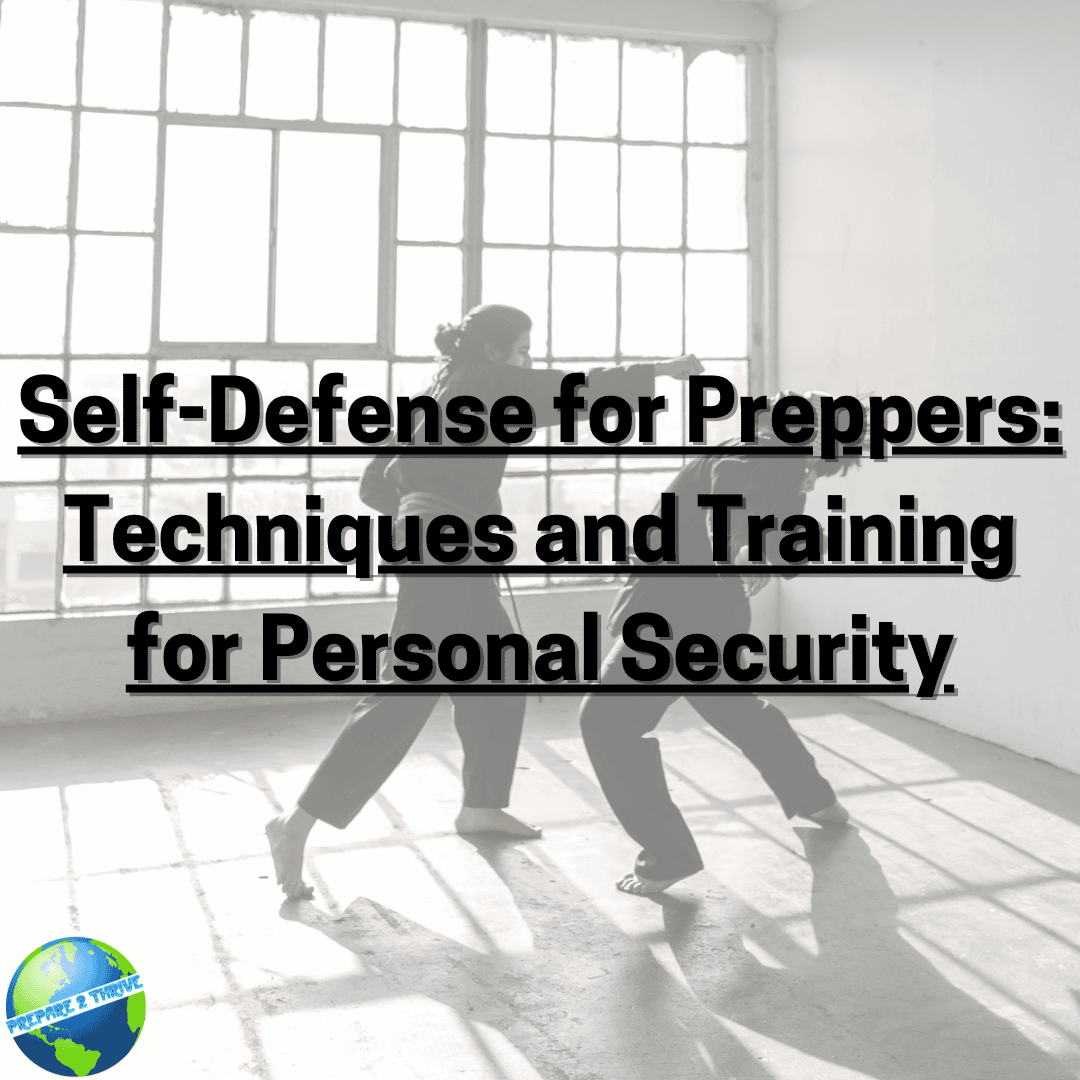I. Introduction
A. Definition of preppers and their focus on preparedness
Preppers, also known as survivalists or preparedness enthusiasts, are individuals who actively engage in preparing for various emergencies and potential disasters. They understand the importance of being self-reliant and self-sufficient in times of crisis. Preppers focus on acquiring the necessary skills, knowledge, and resources to survive and thrive during challenging situations.
B. Importance of self-defense in a prepper's mindset
In a world where uncertainties can arise at any moment, self-defense becomes a critical component of a prepper's mindset. Preppers recognize that personal security is paramount, as it allows them to protect themselves and their loved ones in dangerous situations. By prioritizing self-defense, preppers are better equipped to handle potential threats and maintain control over their safety and well-being.
C. Purpose of the article: Techniques and training for personal security
The purpose of this article is to provide preppers with valuable insights into self-defense techniques and training methods specifically tailored to enhance personal security. By exploring various aspects of self-defense, including physical techniques, mental preparedness, and the use of appropriate tools, preppers can further fortify their overall preparedness strategy. Whether you are new to self-defense or seeking to expand your skillset, this article will serve as a comprehensive guide to empower you with the knowledge and techniques necessary to safeguard yourself and your loved ones.
II. Understanding Self-Defense
A. Definition and objectives of self-defense
Self-defense refers to a set of techniques and strategies designed to protect oneself from physical harm or danger. The primary objectives of self-defense include preventing or escaping from an attack, minimizing the risk of injury, and ensuring personal safety. It encompasses a wide range of skills, including physical techniques, mental preparedness, and situational awareness.
B. Legal considerations and the use of reasonable force
When engaging in self-defense, it is crucial to understand the legal implications and considerations. Laws surrounding self-defense vary between jurisdictions, but generally, individuals have the right to defend themselves when facing imminent harm. However, the use of force must be proportionate and reasonable in relation to the threat encountered. Understanding the legal framework and seeking proper legal advice is essential to ensure you act within the boundaries of the law.
C. Mental preparedness and situational awareness
Self-defense is not solely about physical techniques; mental preparedness and situational awareness play vital roles as well. Developing a strong mindset, being aware of one's surroundings, and assessing potential threats can help avoid dangerous situations or respond effectively if confronted. By cultivating mental resilience and honing situational awareness skills, preppers can anticipate risks, make informed decisions, and act with confidence in high-pressure scenarios.
III. Physical Techniques for Self-Defense
A. Basic striking techniques: punches, kicks, and knee strikes
Basic striking techniques form the foundation of physical self-defense. Learning effective punches, kicks, and knee strikes allows preppers to generate power, maintain distance, and target vulnerable areas on an assailant's body. Proper form, balance, and technique are essential for maximizing the impact of these strikes.
B. Defensive techniques: blocks and parries
Defensive techniques are crucial for protecting oneself from incoming attacks. Blocks and parries involve using appropriate body positioning, arm movements, and timing to deflect or redirect an assailant's strikes. Mastering these defensive maneuvers enables preppers to create openings for counterattacks or create space to escape.
C. Grappling and restraining techniques: joint locks and holds
Grappling and restraining techniques are valuable skills in close-quarters combat situations. Learning joint locks, holds, and submission techniques allows preppers to control an assailant, neutralize their ability to harm, and buy time for assistance or escape. These techniques require proper training and an understanding of leverage and body mechanics.
D. Effective use of improvised weapons
In self-defense scenarios, improvised weapons can provide an advantage when confronted with an assailant or threat. Understanding how to identify and utilize everyday objects as improvised weapons can significantly increase the chances of successfully defending oneself. Techniques such as utilizing a key as a makeshift striking tool or employing a pen for pressure point attacks can turn ordinary objects into effective defensive tools.
E. The role of martial arts in self-defense training
Martial arts training can be an invaluable resource for self-defense. Various martial arts disciplines offer techniques, strategies, and philosophies that enhance personal security. From traditional disciplines like karate and taekwondo to practical systems such as Krav Maga or Brazilian Jiu-Jitsu, martial arts training provides preppers with a comprehensive skill set, physical fitness, and mental discipline to effectively defend themselves.
IV. Training for Self-Defense
A. Physical fitness and conditioning for self-defense
Physical fitness and conditioning are essential for effective self-defense. Engaging in regular exercise, strength training, and cardiovascular activities improve overall physical capabilities, stamina, and endurance. A prepper's fitness routine should include exercises that enhance speed, agility, flexibility, and strength, which are crucial for executing self-defense techniques with precision and power.
B. Finding a reputable self-defense instructor or martial arts school
Finding a reputable self-defense instructor or martial arts school is crucial for acquiring proper training. Look for instructors or schools with experienced, knowledgeable instructors who emphasize safety, realistic training, and practical self-defense techniques. Research their credentials, teaching methodologies, and reviews from other students to ensure you're learning from qualified professionals.
C. Regular practice and drills for muscle memory
Regular practice and drills are essential for developing muscle memory in self-defense techniques. Repetition helps engrain proper form, timing, and execution of strikes, blocks, and other defensive maneuvers. By consistently practicing these skills, preppers can react quickly and instinctively during high-stress situations, increasing their chances of effectively defending themselves.
D. Scenario-based training to simulate real-life situations
Scenario-based training is a valuable tool for self-defense preparation. Simulating real-life situations allows preppers to apply their skills and decision-making abilities in a controlled yet realistic environment. By practicing in scenarios that mimic potential threats, preppers can refine their responses, assess situational cues, and adapt their strategies accordingly.
E. Importance of ongoing training and skill development
Ongoing training and skill development are vital in self-defense. Self-defense techniques and strategies continue to evolve, and preppers must stay updated with the latest advancements. Additionally, maintaining regular training sessions ensures that skills are honed, physical fitness is sustained, and mental preparedness is maintained. Continuous learning and improvement enhance a prepper's ability to protect themselves effectively.
V. Mental and Emotional Aspects of Self-Defense
A. Developing a survival mindset
Developing a survival mindset is crucial for effective self-defense. It involves adopting a proactive and resilient mindset, being mentally prepared to assess threats, and making quick decisions in high-pressure situations. A survival mindset enables preppers to stay focused, adapt to changing circumstances, and take necessary actions to protect themselves and others.
B. Managing fear and stress during a confrontation
Managing fear and stress is essential for maintaining composure during a self-defense confrontation. Preppers must learn techniques to control their emotions, stay calm, and think rationally under pressure. Breathing exercises, visualization techniques, and mental rehearsal can help preppers manage fear and stress effectively, enabling them to respond with clarity and efficiency.
C. Verbal de-escalation techniques
Verbal de-escalation techniques are valuable tools in self-defense situations. Learning to defuse potential conflicts through effective communication can help prevent physical altercations. Preppers should practice techniques such as active listening, assertive communication, and using calming language to mitigate tense situations and create opportunities for resolution without resorting to violence.
D. Understanding the fight-or-flight response
The fight-or-flight response is a natural physiological and psychological reaction during high-stress situations. Understanding this response can help preppers recognize their own reactions and manage them effectively. By learning techniques to harness the adrenaline rush and channel it into focused action, preppers can optimize their self-defense performance and increase their chances of a favorable outcome.
VI. Self-Defense Equipment and Tools
A. Pepper spray, stun guns, and tasers
Pepper spray, stun guns, and tasers are non-lethal self-defense tools that can incapacitate or deter an assailant. Understanding their proper use, range, and legal restrictions is important. Preppers should familiarize themselves with the operation and maintenance of these tools and consider their suitability for personal security needs.
B. Personal alarms and whistles
Personal alarms and whistles are simple yet effective tools for self-defense. These devices emit loud, attention-grabbing sounds that can startle an attacker, attract help from nearby individuals, and potentially discourage further aggression. Carrying a personal alarm or whistle provides an additional layer of personal security, especially in situations where physical confrontation may be avoided.
C. Tactical flashlights and their utility
Tactical flashlights are versatile tools that serve multiple purposes in self-defense. They can disorient an assailant by temporarily impairing their vision, provide illumination in low-light environments, and serve as an improvised striking tool. Choosing a reliable and durable tactical flashlight with appropriate brightness levels and features enhances personal security and situational awareness.
D. Choosing the right self-defense tools for your needs
When selecting self-defense tools, it's important to consider personal preferences, legal regulations, and the specific threats you may encounter. Conduct thorough research, seek professional advice, and assess your comfort level and proficiency with different tools. Choosing the right self-defense tools that align with your skills, lifestyle, and legal requirements enhances your overall preparedness and personal security.
VII. Home Security and Self-Defense
A. Securing your home: locks, alarms, and reinforcements
Securing your home is paramount for personal safety. Implementing robust door and window locks, installing reliable alarm systems, and reinforcing vulnerable entry points can significantly deter intruders. Preppers should assess their home's security vulnerabilities and take necessary measures to fortify their residence, creating a strong line of defense against potential threats.
B. Creating a safe room or shelter-in-place area
Creating a safe room or shelter-in-place area within your home is a proactive self-defense measure. This designated space should be fortified and stocked with essential supplies, such as emergency communication devices, food, water, and first aid kits. In the event of a home invasion or other threats, a safe room provides a secure location for you and your family to seek refuge and await assistance.
C. Home defense strategies and planning
Developing home defense strategies and planning is crucial for self-defense preparedness. This includes establishing communication and emergency protocols with family members, practicing home evacuation drills, and having a plan for contacting emergency services. Being proactive in assessing potential risks, implementing security measures, and rehearsing response strategies ensures that you are well-prepared to protect yourself and your loved ones in a home defense situation.
VIII. Legal Considerations
A. Understanding self-defense laws and your rights
Understanding self-defense laws and your rights is crucial for responsible and lawful self-defense. Familiarize yourself with the self-defense laws in your jurisdiction, including the definition of reasonable force, the duty to retreat, and the legal requirements for claiming self-defense. Knowing your rights and legal limitations empowers you to make informed decisions in high-stress situations.
B. When to use force and when to retreat
Knowing when to use force and when to retreat is a critical aspect of self-defense. Assessing the level of threat, evaluating the availability of alternative options, and considering the potential consequences are essential factors in making this determination. Understand the concept of proportional force and prioritize personal safety while staying within the boundaries of the law.
C. The importance of documenting incidents and seeking legal counsel
The importance of documenting incidents and seeking legal counsel cannot be overstated. In the aftermath of a self-defense incident, documenting the details, gathering evidence, and obtaining witness statements can be crucial in establishing the justifiability of your actions. Additionally, consulting with a qualified attorney specializing in self-defense law ensures that your rights are protected and helps navigate any legal implications that may arise.
IX. Preparing for Self-Defense in SHTF Scenarios
A. Additional challenges in survival scenarios
In SHTF (S**t Hits The Fan) scenarios, self-defense poses unique challenges due to the breakdown of societal order and limited resources. Preppers should anticipate the increased risks and uncertainties during such situations, including potential threats from desperate individuals or groups. Understanding these challenges helps preppers adapt their self-defense strategies accordingly.
B. Self-defense strategies when resources are limited
When resources are limited, preppers must employ resourceful and adaptive self-defense strategies. This may involve utilizing improvised weapons, employing stealth and evasion techniques, or focusing on non-confrontational approaches to minimize risks. Prioritizing situational awareness, strategic planning, and the ability to assess and exploit the environment are essential for effective self-defense in resource-constrained scenarios.
C. The role of self-defense training in prepping
Self-defense training plays a vital role in prepping by equipping individuals with the necessary skills, knowledge, and mindset to protect themselves and their loved ones in various scenarios. Regular self-defense training hones physical abilities, enhances situational awareness, and develops the mental resilience needed to overcome challenges. Integrating self-defense training into prepping efforts strengthens overall preparedness.
X. Conclusion
A. Recap of self-defense techniques and training discussed
In this article, we have explored various self-defense techniques and training methods for personal security. We have discussed the importance of physical techniques, mental preparedness, and the role of equipment and tools in self-defense.
B. Emphasize the importance of ongoing practice and preparation
It is important to emphasize the significance of ongoing practice and preparation in self-defense. Regular training, continuous skill development, and staying updated with self-defense laws and best practices are key to maintaining a high level of readiness.
C. Encouragement for readers to prioritize their personal security and preparedness
We encourage readers to prioritize their personal security and preparedness. Self-defense is an essential aspect of being a prepper, and by investing time and effort into acquiring the necessary skills and knowledge, individuals can enhance their ability to protect themselves and their loved ones.
Hashtags:
#SelfDefense #Preppers #PersonalSecurity #Preparedness #MartialArts #Training #Survival #HomeSecurity



